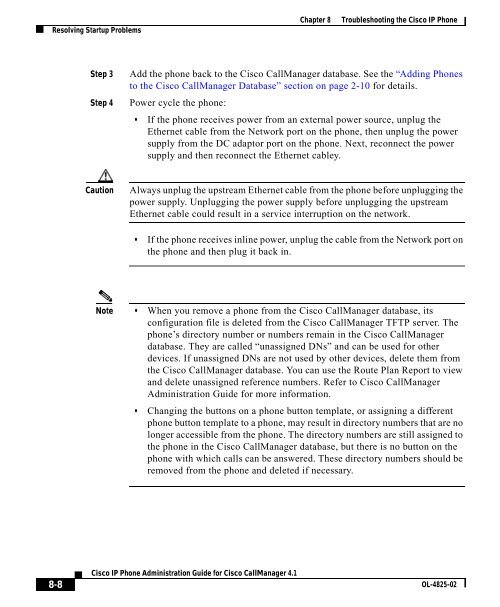8 Troubleshooting the Cisco IP Phone
8 Troubleshooting the Cisco IP Phone
8 Troubleshooting the Cisco IP Phone
Create successful ePaper yourself
Turn your PDF publications into a flip-book with our unique Google optimized e-Paper software.
Resolving Startup ProblemsChapter 8 <strong>Troubleshooting</strong> <strong>the</strong> <strong>Cisco</strong> <strong>IP</strong> <strong>Phone</strong>Step 3Step 4Add <strong>the</strong> phone back to <strong>the</strong> <strong>Cisco</strong> CallManager database. See <strong>the</strong> “Adding <strong>Phone</strong>sto <strong>the</strong> <strong>Cisco</strong> CallManager Database” section on page 2-10 for details.Power cycle <strong>the</strong> phone:• If <strong>the</strong> phone receives power from an external power source, unplug <strong>the</strong>E<strong>the</strong>rnet cable from <strong>the</strong> Network port on <strong>the</strong> phone, <strong>the</strong>n unplug <strong>the</strong> powersupply from <strong>the</strong> DC adaptor port on <strong>the</strong> phone. Next, reconnect <strong>the</strong> powersupply and <strong>the</strong>n reconnect <strong>the</strong> E<strong>the</strong>rnet cabley.CautionAlways unplug <strong>the</strong> upstream E<strong>the</strong>rnet cable from <strong>the</strong> phone before unplugging <strong>the</strong>power supply. Unplugging <strong>the</strong> power supply before unplugging <strong>the</strong> upstreamE<strong>the</strong>rnet cable could result in a service interruption on <strong>the</strong> network.• If <strong>the</strong> phone receives inline power, unplug <strong>the</strong> cable from <strong>the</strong> Network port on<strong>the</strong> phone and <strong>the</strong>n plug it back in.Note • When you remove a phone from <strong>the</strong> <strong>Cisco</strong> CallManager database, itsconfiguration file is deleted from <strong>the</strong> <strong>Cisco</strong> CallManager TFTP server. Thephone’s directory number or numbers remain in <strong>the</strong> <strong>Cisco</strong> CallManagerdatabase. They are called “unassigned DNs” and can be used for o<strong>the</strong>rdevices. If unassigned DNs are not used by o<strong>the</strong>r devices, delete <strong>the</strong>m from<strong>the</strong> <strong>Cisco</strong> CallManager database. You can use <strong>the</strong> Route Plan Report to viewand delete unassigned reference numbers. Refer to <strong>Cisco</strong> CallManagerAdministration Guide for more information.• Changing <strong>the</strong> buttons on a phone button template, or assigning a differentphone button template to a phone, may result in directory numbers that are nolonger accessible from <strong>the</strong> phone. The directory numbers are still assigned to<strong>the</strong> phone in <strong>the</strong> <strong>Cisco</strong> CallManager database, but <strong>the</strong>re is no button on <strong>the</strong>phone with which calls can be answered. These directory numbers should beremoved from <strong>the</strong> phone and deleted if necessary.8-8<strong>Cisco</strong> <strong>IP</strong> <strong>Phone</strong> Administration Guide for <strong>Cisco</strong> CallManager 4.1OL-4825-02
















